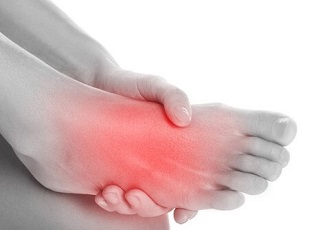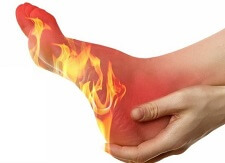- Home
- Foot Symptoms
- Swollen Feet and Ankles
- Why Are My Feet Swollen
Why Are My Feet Swollen?
Written By: Chloe Wilson BSc(Hons) Physiotherapy
Reviewed By: FPE Medical Review Board
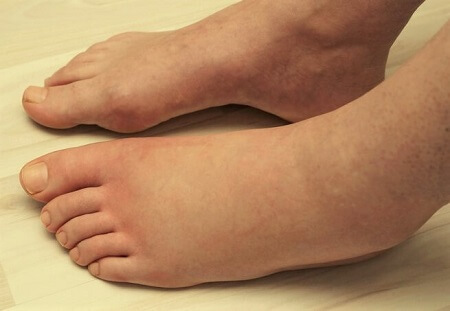
A common question that most of us will ask at least once in our lives is why are my feet swollen?
Foot and ankle swelling might simply be your body’s way of telling you to take a break, there may be an underlying medical condition or in some cases it could be that something serious is going on.
The good news is that most cases of swollen ankles and feet are not serious and can be managed effectively at home. Here we look at what causes swollen feet, what you can do to help and what signs to look for so that to know when you need to see your doctor.
1. Foot Injuries
Damage to any of the foot and ankle structures such as broken bones, sprained ligaments or tendon damage can result in swelling feet. With a foot injury, blood rushes to the area as part of the healing process, bringing in much-needed nutrients and oxygen, but the downside of that is foot swelling.
Treatment for swollen feet will depend on the type of foot injury but the best place to start is with:
- Rest: keep you weight off your foot to allow it to heal and prevent further injury
- Ice: Apply an ice pack for 10-15 minutes every couple of hours to reduce pain and swelling
- Compression: A compression bandage such as tubigrip helps to reduce swelling and provides support to the ankle
- Elevation: Keep your foot/feet raised, preferably above your heart, so gravity draws fluid away from the swollen feet
- Medication: Can help reduce pain and swelling after a foot injury
- Seek Medical Advice: If your symptoms persist or you are experiencing significant pain and/or disability, get checked out by your doctor
2. Oedema
Oedema, also spelt edema, is a common condition where the body stores excess fluid in the tissues, known as fluid retention. The feet and ankles are the most common area to experience oedema as gravity draws the fluid down, but it can occur in the face and arms.
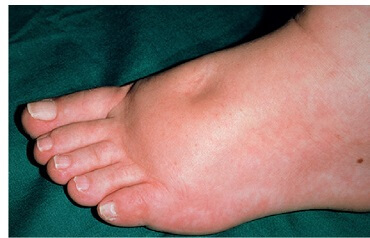
Classic symptoms of oedema include:
- Puffiness around the feet and ankles
- Tight, shiny skin
- Stiff, achy joints
- Difficulty walking
- When pressed, a temporary indent may be left in the skin, known as pitting oedema
Many cases of mild oedema settle down by themselves but treatment options include:
- Support Stockings: or tubigrip compression bandage, place gentle pressure on the legs to reduce swelling
- Elevation: Rest with your legs elevated on a pillow or with your leg up against the wall - you are aiming to have your foot higher than your heart for maximum benefit
- Reduce Salt Intake
- Medications: such as diuretics aka water tablets
3. Lifestyle Factors
Certain lifestyle factors can lead to foot and ankle swelling such as
- Being on your feet all-day
- Sitting for long periods
- Obesity
- Wearing tight shoes
Simple measures such as keeping active, moving around regularly rather than staying in one position, regular exercise, weight loss (if appropriate) and comfortable footwear can make a real difference with swollen feet.
4. Pregnancy
Most pregnant women will notice their feet and ankles swelling at some point, most commonly in the third trimester, as the body naturally produces more blood and fluids and retains more water during pregnancy. There is also more pressure on blood vessels affecting circulation.
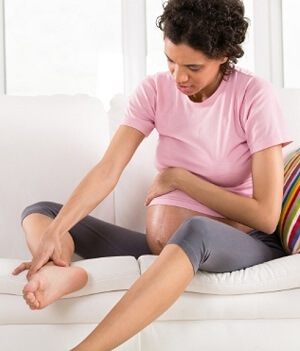
Most cases of swollen feet in pregnancy fluctuate and are not serious but sudden foot swelling can be a sign of pre-eclampsia, a condition linked with high blood pressure which can be very serious.
Typical signs of pre-eclampsia usually develop in the second half of pregnancy and include:
- Sudden or severe foot swelling
- Headaches and/or dizziness
- Nausea and/or vomiting
- Abnormal vision
- Breathing difficulties
- Decreased urination
If you have any of these symptoms during pregnancy, see your doctor immediately.
5. Hot Weather
During hot weather feet and ankles often swell up as your veins expand to help keep you cool. This pushes fluids out into the surrounding tissues which then pools in your feet.
If you are prone to foot swelling and pain in hot weather try to:
- Keep Cool: e.g. air conditioning, cold water foot bath, light clothing
- Drink Plenty Of Water
- Footwear: Wear light, loose-fitting footwear or go barefoot
6. Chronic Venous Insufficiency
Chronic Venous Insufficiency, CVI, is a condition where the valves in the leg veins don’t work properly, making it hard for them to pump blood back up from the feet, against gravity, to the heart. Blood seeps back down and fluid pools around the feet and ankles.
Treatment for foot swelling from CVI includes:
- Avoiding Prolonged Sitting/Standing: Keep moving or do gentle exercises every 20-30 minutes
- Elevation: When resting keep your feet elevated, if possible higher than your heart
- Regular Walks: or other forms of exercise
- Compression Stockings
7. Heart Failure
Ankle and foot swelling may be a sign that the heart is not pumping blood around the body correctly. Pressure builds up in the blood vessels causing fluid to seep out into the surrounding tissues and collects around the ankles due to gravity.
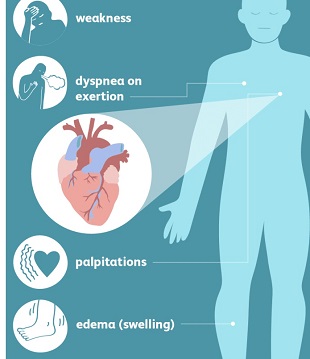
With heart failure, as well as swollen feet you may also experience:
- Increased or irregular heart rate
- Shortness of breath: particularly when lying down or with exercise
- Persistent cough: may cough up pink/red phlegm
- Weakness: and fatigue
- Nausea: and/or vomiting
- Loss of appetite
- Rapid weight gain: due to fluid retention
- Confusion or difficulty focussing
- Abdominal swelling
- Increased urination: particularly at night
Heart failure requires ongoing medical care including medication, lifestyle changes and in some cases surgery.
8. Kidney Disease
If the kidneys aren’t working properly, they can’t filter salt and fluid effectively out of the blood which leads to fluid retention. Common symptoms of kidney disease include
- Swollen feet & ankles - typically worse in the morning
- Shortness of breath
- Excessive thirst
- Increased urination and/or foamy, bubbly or discoloured urine
- Fatigue, weakness, dizziness & difficulty concentrating
- Severe itching
- Feeling cold
Treatment for kidney disease includes:
- Medication: e.g. for high blood pressure and cholesterol
- Diuretics: aka water tablets
- Supplements: Such as Vitamin D and Calcium
- Low Protein Diet
- Intervention: Severe cases of kidney failure may require dialysis or transplant surgery
9. Liver Disease
The liver filters blood and makes proteins that are important for blood clotting. If the liver isn’t working properly then fluid leaks out of the blood and pools in the feet. Symptoms of liver disease include:
- Jaundice: Skin and eyes have a yellowy tinge
- Swelling in the legs, ankles & feet
- Swollen, painful abdomen from ascites
- Dark urine and/or stools
- Loss of appetite and/or nausea
- Fatigue
- Bruise and bleed more easily e.g. nosebleeds
- Significant weight loss
Liver function will be closely monitored by your doctor and treatment for liver disease may include:
- Lifestyle Changes: e.g. weight loss and exercise
- Reduce Alcohol Intake: it may be necessary to abstain completely
- Medications
- Surgery
10. Foot Infection
Fungal and bacterial infections often cause swollen feet. Typical infections that lead to the feet swelling include:
- Fungal Infections: such as Athlete’s Foot
- Bacterial Infections: can enter the skin through cuts and wounds and may result in cellulitis
- Infected Blisters: Yellow or green pus develops in an infected blister
- Post Surgical Infection: Infection is a rare side effect of foot surgery
Your doctor may prescribe antibiotics to help treat the infection and reduce foot swelling.
11. Lymphedema
Fluid circulates in the lymphatic system as part of the body’s immune system. Damage to or removal of lymph nodes, most commonly during cancer treatment, causes excess lymph fluid to collect in the surrounding tissues causing arm, leg, ankle and foot swelling.
There is no specific cure for lymphedema but there are a number of things you can do to reduce the pain and swelling such as:
- Massage: Lymph drainage massage helps push the fluid back into the lymphatic system for reabsorption
- Compression: Elasticated bandages, compression garments or pneumatic compression pumps (inflatable sleeves)
- Gentle Exercise: to encourage circulation and lymph drainage
- Surgery: for severe cases of lymphedema
12. Blood Clot
When the blood clots or flows abnormally, a gel-like clump of platelets and fibrin forms. When this happens in the leg veins, it can impede blood flow back to the heart causing foot and ankle swelling.
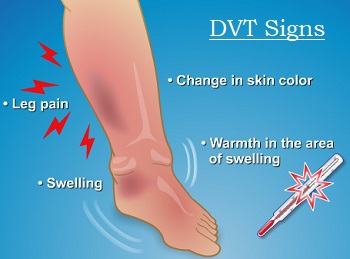
If a blood clot forms in the deep leg veins, known as a DVT, it can cause a serious blockage requiring immediate medical attention.
Typical signs of a DVT are:
- Severe ankle or calf swelling and pain
- Skin redness
- Tenderness
- Increased Temperature
Treatment & prevention measures for blood clots may involve:
- Blood Thinning Medication: such as aspirin or warfarin
- Regular Exercise
- Avoid Prolonged Postures: especially sitting for long periods e.g. on a plane
- Drink Plenty
- Compression Stockings
13. Foot Gout
Swelling in the big toe is a common sign of foot gout, a type of inflammatory arthritis caused by a buildup of uric acid crystals. Symptoms of gout foot usually develop suddenly and rapidly at nighttime and as well as toe and foot swelling there is usually intense pain and the skin appears red and hot.
Gout foot usually settles down on its own in a couple of weeks but there are various medications that can help to reduce the foot pain and swelling and prevent further attacks such as NDSAIDs, corticosteroids and colchicine.
14. Alcohol
Your body retains more water when you drink alcohol which can lead to foot and ankle swelling. Usually, it settles down in a couple of days. If you notice frequent swelling after consuming alcohol it could be a sign of an underlying problem with your heart, liver or kidneys and you should get checked out by your doctor.
How To Treat Swollen Feet
Many causes of swelling feet can be treated at home with a combination of:
- RICE: Rest, Ice, Compression & Elevation
- Reduce Salt Intake
- Drink Plenty of Fluids: preferably water
- Rest With Your Legs Elevated: ideally with your feet higher than your heart e.g. on a leg elevation cushion
- Compression or Support Stockings
- Keep Moving: Avoid extended periods of standing, walking, or sitting
- Keep Cool: in hot weather
- Appropriate Footwear: comfortable, loose-fitting shoes
- Leg & Ankle Exercises: Particularly when sitting down to keep the fluid pumping round
- Massage: To help move the fluid away from the feet and back to the lymphatic system
- Lose Weight: Only appropriate if you are overweight
- Reduce Alcohol Intake
Find out loads more in the swollen foot treatment section
When To Call The Doctor
Most causes of swollen feet and ankles are nothing to worry about and can be treated at home but if you have any of the following symptoms you should seek immediate medical attention:
- Shortness of breath
- Chest pain, tightness or pressure
- Severe pain
- Unable to weight bear
- Swollen, red, hot calf region
- Indent remains in skin after you’ve pressed it
If your symptoms are less severe but your foot swelling persists for more than a few days despite using the treatment methods discussed above, then see your doctor. They can run tests to see if there is an underlying medical condition and give you a definitive answer to the question, why are my feet swollen.
Related Articles
Page Last Updated: 23rd January, 2025
Next Review Due: 23rd January, 2027
